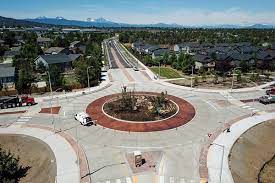Roundabout Revolution: The history of Bend’s love/hate relationship with RABs
The “Roundabout Revolution” in Bend started with a single intersection on Century Drive and a traffic control concept borrowed from Europe..
It was the city’s first roundabout and Oregon’s first roundabout, built in 1999.
“We were a small enough city at that time, just under 50,000,” says City Traffic Engineer Robin Lewis. “We didn’t have any traffic controls other than stop signs on the West side of Bend.”
Developer Mike Hollern, CEO of Brooks Resources, knew the intersection well and knew change was coming to the West Side. “Traffic was picking up to the point something needed to be done at this intersection and what the planners from the city were talking about was either a signal or a three-way stop sign; In either event it would have required the removal of those large 150-year old plus Ponderosa Pines,” he said. “I’d spent some time in Europe and had seen how well roundabouts worked there and it seemed like an obvious place for it.”
But it wasn’t just his love of nature. Hollern freely admits to other motives as well. “At the same time, we owned property all around here. And that road (what is now SW Chandler) did not exist. But we also wanted access to that part of the property, the Century/Washington Center.” he said.
So, his company paid for it and built it with permission from the city. It also required a sign-off from ODOT because Century Dr. was a state highway at the time. Hollern says that first roundabout (or “RAB” in traffic planner shorthand) cost $300,000 to $400,000 dollars.
The price has gone up of course, way up over the years. A recently installed two-lane RAB at the intersection of 27th, Butler Market and Empire, cost $6.3 million.
“We’re all in now,” Lewis said. “I think we’ve normalized roundabouts for our region and that was really one of our goals.”
Bend now has 42 of them with more in the works. Study after study shows there are fewer and less severe accidents than at intersections governed by traffic lights. Cars keep moving rather than sitting, idling and pumping out exhaust. But is this happening at intersections all over the country? We checked other u.s. cities about the same size as Bend and found none of them with anywhere near 42 roundabouts.
Renton, Washington has one, another on the way. Spokane Valley, Washington has six. Vacaville, California has two with a few more in design phase.. Vista, California; five. San Angelo and Edinburg, Texas, both at zero. Davenport, Iowa; two. In Tuscaloosa, Alabama the traffic chief tells us they have two and a half. And then we come to Carmel, Indiana, the true “Roundabout City USA.”
Mayor Jim Brainard is proud to lay out the numbers. “We have 138 today and seven more under construction,” he tells us. Jim has been mayor for 25 years and roundabouts have helped keep residents happy and keep him in office.
“When we first started there was a lot of skepticism. But then people started to drive them. I couldn’t remove one today if I wanted to,” he said. “The fight is over who’s going to get the next one.”
Traffic roundabouts can be a little unnerving if you’re not used to this kind of intersection but Central Oregon drivers have largely accepted them.
Not that there’s much of a choice at this point. At Bend’s Kittelson & Associates office, where they helped design that first roundabout, Matt Kittelson sees more coming. “The $190 million transportation bond the city passed includes a number of roundabouts,” he said. ” think depending on the preferred alternatives and how it works out it could be another dozen in Bend.”
According to Principal Engineer Scott Beaird, the firm has now designed about 1,000 RABs in North America and literally written the book on how to build them
“We wrote the initial roundabout design guide for the Federal Highway Administration,” he said. “We wrote the follow-up to that and we’re currently working on the third edition.”
All roundabouts are different, Scott says, but the basic concepts and goals remain the same: make it safe, keep speeds down, keep traffic moving as much as possible.
Make it obvious to drivers they should yield to traffic going in, signal going out and watch for cyclists and pedestrians.
And the advice from Mayor Brainard in Carmel?
“Hang in there and keep building them.”

